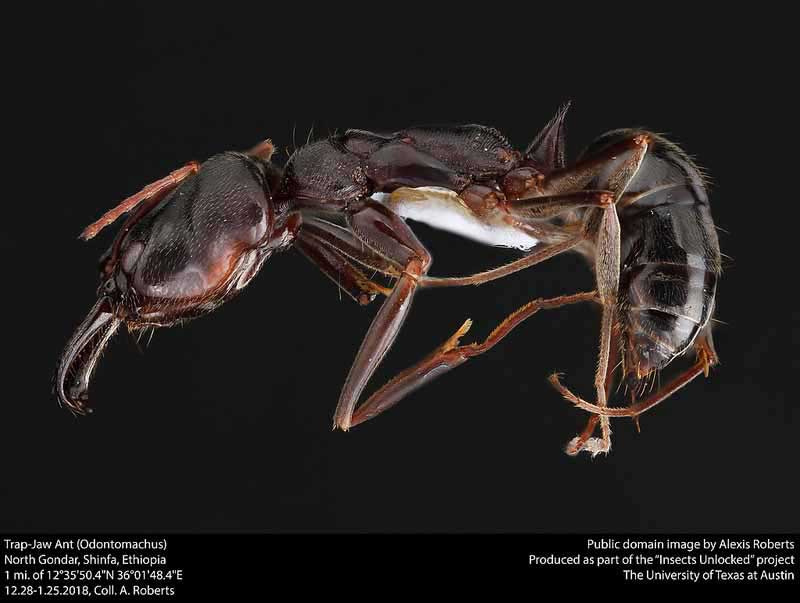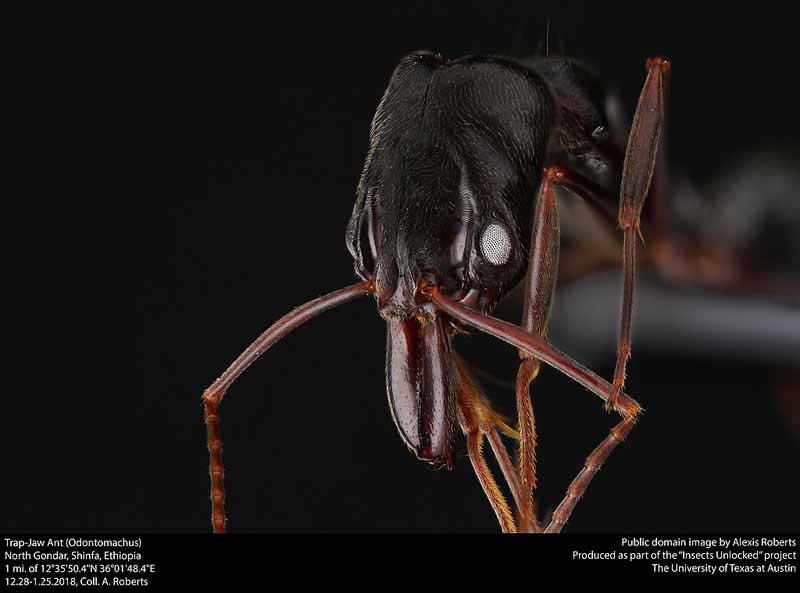
Superregnum: Eukaryota
Cladus: Unikonta
Cladus: Opisthokonta
Cladus: Holozoa
Regnum: Animalia
Subregnum: Eumetazoa
Cladus: Bilateria
Cladus: Nephrozoa
Cladus: Protostomia
Cladus: Ecdysozoa
Cladus: Panarthropoda
Phylum: Arthropoda
Subphylum: Hexapoda
Classis: Insecta
Cladus: Dicondylia
Subclassis: Pterygota
Cladus: Metapterygota
Infraclassis: Neoptera
Cladus: Eumetabola
Cladus: Endopterygota
Superordo: Hymenopterida
Ordo: Hymenoptera
Subordo: Apocrita
Superfamilia: Formicoidea
Familia: Formicidae
Subfamilia: Ponerinae
Tribus: Ponerini
Genus: Odontomachus
Species (66): O. aciculatus – O. affinis – O. allolabis – O. angulatus – O. animosus – O. assiniensis – O. banksi – O. bauri – O. biolleyi – O. biumbonatus – O. bradleyi – O. brunneus – O. caelatus – O. cephalotes – O. chelifer – O. circulus – O. clarus – O. coquereli – O. cornutus – O. davidsoni – O. erythrocephalus – O. floresensis – O. fulgidus – O. granatus – O. haematodus – O. hastatus – O. imperator – O. infandus – O. insularis – O. laticeps – O. latidens – O. latissimus – O. litoralis – O. macrorhynchus – O. malignus – O. mayi – O. meinerti – O. montanus – O. monticola – O. mormo – O. nigriceps – O. opaciventris – O. opaculus – O. panamensis – O. papuanus – O. peruanus – O. pseudobauri – O. rixosus – O. ruficeps – O. rufithorax – O. ruginodis – O. saevissimus – O. scalptus – O. silvestrii – O. simillimus – O. spinifer – O. spissus – O. sumbensis – O. tensus – O. testaceus – O. troglodytes – O. turneri – O. tyrannicus – O. unispinosus – O. xizangensis – O. yucatecus
Source(s) of checklist:
Checklist based uncritically on Catalogue of Life: 2014 Annual Checklist
Add (7): O. alius – O. desertorum – O. minangkabau – O. philippinus – O. relictus – O. schoedli – O. scifictus
Name
Odontomachus Latreille, 1804

References
Latreille, P.A. 1804. Histoire naturelle, générale et particulière, des crustacés et des insectes. 12: 1–424. F. Dufart (Paris). BHL Reference page.
Brown, W. L. 1976: Contributions toward a reclassification of the Formicidae. VI. Ponerinae, tribe Ponerini, subtribe Odontomachiti. Section A. Introduction, subiribal characters. Genus Odontomachus. — Studia Entomologica (N.S.) 19: 67–17!.
Hoenle, P., Lattke, J.E., Donoso, D., von Beeren, C., Heethoff, M., Schmelzle, S., Argoti, A., Camacho, L.F., Ströbel, B. & Blüthgen, N. 2020. Odontomachus davidsoni sp. nov. (Hymenoptera, Formicidae), a new conspicuous trap-jaw ant from Ecuador. ZooKeys 948: 75–105. DOI: 10.3897/zookeys.948.48701 Open access Reference page.
MacGown, J.A. et al. 2014: A review of the Nearctic Odontomachus (Hymenoptera: Formicidae: Ponerinae) with a treatment of the males. Zootaxa 3802(4): 515–552. DOI: 10.11646/zootaxa.3802.4.6 Reference page.
Satria, R., Kurushima, H., Herwina, H., Yamane, S. & Eguchi, K. 2015. The trap-jaw ant genus Odontomachus Latreille (Hymenoptera: Formicidae) from Sumatra, with a new species description. Zootaxa 4048(1): 1–36. DOI: 10.11646/zootaxa.4048.1.1. Preview (PDF) Reference page.
Sorger, D.M.; Zettel, H. 2011: On the ants (Hymenoptera: Formicidae) of the Philippine Islands: V. The genus Odontomachus Latreille, 1804. Myrmecological news 14: 141-163. Full article (PDF) Reference page.
Wang, W.Y., Yamada, A. & Yamane, S. 2020. Maritime trap-jaw ants (Hymenoptera, Formicidae, Ponerinae) of the Indo-Australian region – redescription of Odontomachus malignus Smith and description of a related new species from Singapore, including first descriptions of males. Zookeys, 915: 137–174. DOI: 10.3897/zookeys.915.38968 Open access Reference page.
Vernacular names
Deutsch: Schnappkieferameisen
magyar: Pattanóhangya
Nederlands: Klapkaakmieren
Tiếng Việt: Kiến bẫy hàm
Odontomachus is a genus of ants commonly called trap-jaw ants found in the tropics and subtropics throughout the world.
Overview
Head of O. hastatus
Commonly known as trap-jaw ants, species in Odontomachus have a pair of large, straight mandibles capable of opening 180°. These jaws are locked in place by an internal mechanism, and can snap shut on prey or objects when sensory hairs on the inside of the mandibles are touched. The mandibles are powerful and fast, giving the ant its common name. The mandibles either kill or maim the prey, allowing the ant to bring it back to the nest. Odontomachus ants can simply lock and snap their jaws again if one bite is not enough, or to cut off bits of larger food. The mandibles also permit slow and fine movements for other tasks such as nest building and care of larvae. The ants were also observed to use their jaws as a catapult to eject intruders or fling themselves backwards to escape a threat.[2][3]
The larvae of trap-jaw ants are remarkable[4] in being ornamented with long spikes and presenting dorsal adhesive pads for fixation onto internal ant nest walls.[5] They are carnivorous, extremely active larvae. Apparently, they undergo three larval moults before entering metamorphosis.[5] Their larvae use substrate to spin cocoons.[6]
Diet
Trap-jaw ants are mostly carnivorous, but will also consume nectar, insect honeydew and ripe fruit.[7]
Speed record
Trap-jaw ants of this genus have the second-fastest moving predatory appendages within the animal kingdom,[2] after the dracula ant (Mystrium camillae).[8] One study of Odontomachus bauri recorded peak speeds between 126 and 230 km/h (78 and 143 mph), with the jaws closing within just 130 microseconds on average. The peak force exerted was in the order of 300 times the body weight of the ant, and acceleration of 1,000,000 m/s² or 100,000 g.
Mimicry
The jumping spider genus Enoplomischus seems to mimic this ant genus.[9]
Distribution
Odontomachus species are found in Central and South America, Asia, Australia, and Africa.[10]
In the United States, O. haematodus was "recorded in Alabama back in 1956, but now researchers have officially confirmed that the species has spread across the Gulf Coast, at least as far east as Pensacola, Florida."[11] In the past, O. ruginodis was thought to be confined to the Orlando region, but Magdalena Sorger, a PhD candidate at North Carolina State University, has confirmed a record of O. ruginodis more than 100 miles north of Orlando, in Gainesville, Florida.[12] Odontomachus relictus, however, is only found in "endangered scrub habitat on central Florida’s ancient sand ridges."[13]
Species
O. haematodus larva
Odontomachus paleomyagra
Odontomachus pseudobauri
73 valid species[14]
Odontomachus aciculatus F. Smith, 1863
Odontomachus affinis Guerin-Meneville, 1844
Odontomachus alius Sorger & Zettel, 2011
Odontomachus allolabis Kempf, 1974
Odontomachus angulatus Mayr, 1866
Odontomachus animosus Smith, 1860
Odontomachus assiniensis Emery, 1892
Odontomachus banksi Forel, 1910
Odontomachus bauri Emery, 1892
Odontomachus biolleyi Forel, 1908
Odontomachus biumbonatus Brown, 1976
Odontomachus bradleyi Brown, 1976
Odontomachus brunneus (Patton, 1894)
Odontomachus caelatus Brown, 1976
Odontomachus cephalotes Smith, 1863 (Indonesia, Australia, etc.)
Odontomachus chelifer (Latreille, 1802)
Odontomachus circulus Wang, 1993
Odontomachus clarus Roger, 1861
Odontomachus coquereli Roger, 1861
Odontomachus cornutus Stitz, 1933
Odontomachus desertorum Wheeler, 1915
Odontomachus erythrocephalus Emery, 1890
Odontomachus floresensis Brown, 1976 (Indonesia: Flores)
Odontomachus fulgidus Wang, 1993
Odontomachus granatus Wang, 1993
Odontomachus haematodus (Linnaeus, 1758) (South America, introduced to Australia prior to 1876); type species
Odontomachus hastatus (Fabricius, 1804)
Odontomachus imperator Emery, 1887
Odontomachus infandus Smith, 1858
Odontomachus insularis Guérin-Méneville, 1844
Odontomachus kuroiwae (Matsumura, 1912)
Odontomachus laticeps Roger, 1861
Odontomachus latidens Mayr, 1867
Odontomachus latissimus Viehmeyer, 1914
Odontomachus malignus Smith, 1859
Odontomachus mayi Mann, 1912
Odontomachus meinerti Forel, 1905
Odontomachus minangkabau Satria, Kurushima, Herwina, Yamane & Eguchi, 2015
Odontomachus montanus Stitz, 1925
Odontomachus monticola Emery, 1892
Odontomachus mormo Brown, 1976
Odontomachus nigriceps Smith, 1860
Odontomachus opaciventris Forel, 1899
Odontomachus opaculus Viehmeyer, 1912
†Odontomachus paleomyagra Wappler, Dlussky, Engel, Prokop & Knor, 2014[15]
Odontomachus panamensis Forel, 1899
Odontomachus papuanus Emery, 1887
Odontomachus pararixosus Terayama & Ito, 2014
Odontomachus peruanus Stitz, 1933
Odontomachus philippinus Emery, 1893
Odontomachus procerus Emery, 1893
†Odontomachus pseudobauri (De Andrade, 1994)
Odontomachus relictus Deyrup & Cover, 2004
Odontomachus rixosus Smith, 1857
Odontomachus ruficeps Smith, 1858 (Australia)
Odontomachus rufithorax Emery, 1911
Odontomachus ruginodis Smith, 1937
Odontomachus saevissimus Smith, 1858
Odontomachus scalptus Brown, 1978
Odontomachus schoedli Sorger & Zettel, 2011
Odontomachus scifictus Sorger & Zettel, 2011
Odontomachus silvestrii W.M. Wheeler, 1927
Odontomachus simillimus F. Smith, 1858 (Australia, Fiji, etc.)
†Odontomachus spinifer De Andrade, 1994
Odontomachus spissus Kempf, 1962
Odontomachus sumbensis Brown, 1976
Odontomachus tensus Wang, 1993
Odontomachus testaceus Emery, 1897
Odontomachus troglodytes Santschi, 1914 (Africa, Madagascar, Inner Seychelles)
Odontomachus turneri Forel, 1900 (Australia)
Odontomachus tyrannicus Smith, 1859
Odontomachus xizangensis Wang, 1993
Odontomachus yucatecus Brown, 1976
References
Bolton, B. (2014). "Odontomachus". AntCat. Retrieved 20 July 2014.
Patek SN, Baio JE, Fisher BL, Suarez AV (22 August 2006). "Multifunctionality and mechanical origins: Ballistic jaw propulsion in trap-jaw ants". Proceedings of the National Academy of Sciences. 103 (34): 12787–12792. Bibcode:2006PNAS..10312787P. doi:10.1073/pnas.0604290103. PMC 1568925. PMID 16924120.
Ant Jaws Break Speed Record — Videos of Odontomachus jumping using its jaws
Pappas, Stephanie; May 11, Live Science Contributor |; ET, 2017 07:41am (11 May 2017). "Weird Ants Have Hairy Blobs for Babies". Live Science. Retrieved 2019-06-28. {{cite web}}: |first2= has generic name (help)
Fox, E.G.P.; Smith, A.A.; Gibson, J.C.; Solis, D.R. (2017). "Larvae of trap-jaw ants, Odontomachus Latreille, 1804 (Hymenoptera: Formicidae): morphology and biological notes". The Austrian Society of Entomofaunistics. 25. doi:10.25849/myrmecol.news_025:017.
"How Trap-Jaw Ants Develop From Larvae Stages [Watch]". Science Times. 2017-05-10. Retrieved 2019-06-28.
Camargo, Rafael X.; Oliveira, Paulo S. (April 2012). "Natural History of the Neotropical Arboreal Ant, Odontomachus hastatus : Nest Sites, Foraging Schedule, and Diet". Journal of Insect Science. 12 (48): 1–9. doi:10.1673/031.012.4801. ISSN 1536-2442. PMC 3476954. PMID 22957686.
"Dracula ants possess fastest known animal appendage: The snap-jaw". ScienceDaily. Retrieved 2018-12-12.
Wesołowska, W. (2005). "A new species of Enoplomischus from Kenya (Araneae: Salticidae: Leptorchestinae)" (PDF). Genus. 16 (2): 307–311. Archived from the original (PDF) on 2007-03-15.
Schmidt, C. A.; Shattuck, S. O. (2014). "The Higher Classification of the Ant Subfamily Ponerinae (Hymenoptera: Formicidae), with a Review of Ponerine Ecology and Behavior". Zootaxa. 3817 (1): 1–242. doi:10.11646/zootaxa.3817.1.1. PMID 24943802.
"Powerful Trap-jaw Ants are Gaining Ground in the Southeastern United States". Entomology Today. 20 June 2014. Retrieved 20 June 2014. "One species called Odontomachus haematodus was unofficially recorded in Alabama back in 1956. But now researchers have officially confirmed that the species has spread across the Gulf Coast, at least as far east as Pensacola, Florida."
"Powerful Trap-jaw Ants are Gaining Ground in the Southeastern United States". Entomology Today. 20 June 2014. Retrieved 20 June 2014. "As recently as a few years ago, another species called Odontomachus ruginodis was thought to be confined to the Orlando region, and points south. But now Sorger has confirmed a record of ruginodis more than a hundred miles north of Orlando, in Gainesville, Florida."
"Powerful Trap-jaw Ants are Gaining Ground in the Southeastern United States". Entomology Today. 20 June 2014. Retrieved 20 June 2014. "Not all of the trap-jaw species are on the move, however. Sorger also studies Odontomachus relictus, a species that is found only in endangered scrub habitat on central Florida’s ancient sand ridges."
An Online Catalog of the Ants of the World by Barry Bolton
An Online Catalog of the Ants of the World: O. paleomyagra
Retrieved from "http://en.wikipedia.org/"
All text is available under the terms of the GNU Free Documentation License

